Themes
Celluloid purses enjoyed a relatively short period of manufacture and popularity. While Parkesine, an earlier fore-runner to celluloid, was created in 1856 and a final form of celluloid was registered in 1870, celluloid purses didn’t burst on the scene until the turn of the century.
Most purses that you find come from a relatively short period between 1900 and 1930. However, even these dates are an approximation based on an analysis of the purse styles and themes and how those relate to fashion. I am still hoping to find dated advertisements of celluloid purses. If you locate any, I would love to see a scanned copy. Please e-mail me.
The primary reasons celluloid purses disappeared are changing styles and the development of newer, cheaper to manufacture, and safer plastics. Celluloid is highly flammable and decomposes easily. In Newark alone, over 36 years, there were 39 fires and explosions causing nine deaths and 39 injuries all related to the manufacture of celluloid. Germany’s first celluloid plant was destroyed by explosion and fire.
Celluloid would be replaced by other plastics including Bakelite (patented in 1909) and Lucite (patented 1937). Celluloid continues to be manufactured today, though it is only used for guitar picks, pick-guards and table tennis balls.
Celluloid purses come in a variety of themes.
Themes include:
Themes in celluloid purses
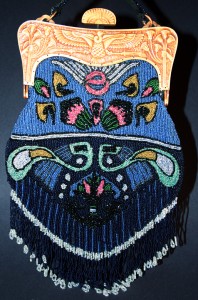 Egypt has exerted its influence on design around the world since the dawn of the pharaohs. The Greek writer Herodotus, exclaimed, “Concerning Egypt itself I shall extend my remarks to a great length, because there is no country that possesses so many wonders, nor any that has such a number of works which defy description.” Greek and Roman cultures were both influenced by Egypt. You might say that an Egyptian Revival of some sort has been going on for more than 2,000 years.
Egypt has exerted its influence on design around the world since the dawn of the pharaohs. The Greek writer Herodotus, exclaimed, “Concerning Egypt itself I shall extend my remarks to a great length, because there is no country that possesses so many wonders, nor any that has such a number of works which defy description.” Greek and Roman cultures were both influenced by Egypt. You might say that an Egyptian Revival of some sort has been going on for more than 2,000 years.
Despite this long-term interest in Egypt, Egyptian Revival as an influence on contemporary design is usually divided into three periods: 1809 – 1840, 1920s, 1970s. The first “revival” in Egyptian-influenced design came on the heels of Napoleon Bonaparte’s expedition to Egypt in 1798. Napoleon brought a number of scholars and scientists with him. They studied Egypt and, beginning in 1809, a series of books, “Description de l’Égypte,” were published. The 23-volume work, along with a number of other books, touched off wide-spread interest in all things Egyptian. This period of Egyptian Revival pre-dates celluloid purses. However, you will find sterling silver and beaded purses from very late in this period with Egyptian themes.
The third Egyptian Revival period came in the 1970s. From 1976 through 1979 the “The Treasures of Tutankhamun” exhibit toured the United States. The exhibit featured 55 objects from the tomb of Tutankhamun and included the boy-king’s solid gold funeral mask, a gilded wood figure of the goddess Selket, lamps, jars, jewelry, furniture, and other objects for the afterlife. This exhibition established the term “blockbuster exhibit” for museums around the world. Visitors waited up to 8 hours to view the exhibition at its various stops and more than 8 million people saw the exhibit.
While both the first and third Egyptian Revivals are interesting, the period of Egyptian Revival that most concerns celluloid purses happened during the 1920s. This Egyptian Revival surrounds the discovery of Tutankhamen’s tomb in 1922 by Howard Carter. The discovery of Tutankhamen’s tomb happened to coincide with the advent of mass media – newspapers, newsreels and movies. The result was that the 1920s Egyptian Revival had an enormous impact on all aspects of design from architecture, fashion, interior design, product packaging and more. It influenced popular culture inspiring countless movies, books,pulps and comics. It also reached far more people than the 1809-1840 revival ever did.
It’s in this revival period that you find celluloid purses. Common iconography of Egyptian Revival celluloid purses include: pharaohs, sphinxes, hieroglyphs, Isis, scarabs, lotus blossoms and pyramids. The designs are not confined to the celluloid frame. Egyptian motifs can be found in the beaded bags that complete many celluloid purses.
Egyptian themed celluloid purses, along with Asian-themed purses, are some of the most popular to collect. This is in part because it appeals to two types of collectors, those who collect purses and those who collect Egyptian Revival objects.
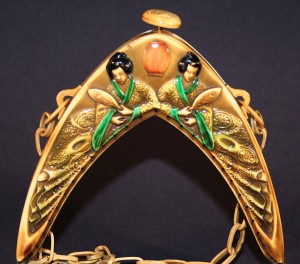 On July 8, 1853, Commodore Matthew Perry sailed into Uraga Harbor near Edo (Tokyo) beginning a series of negotiations to force Japan to acknowledge the United States diplomatically and open trade. The signing of the Convention of Kanagawa on March 31, 1854 would mark the end of Japan’s 200-year policy of isolation.
On July 8, 1853, Commodore Matthew Perry sailed into Uraga Harbor near Edo (Tokyo) beginning a series of negotiations to force Japan to acknowledge the United States diplomatically and open trade. The signing of the Convention of Kanagawa on March 31, 1854 would mark the end of Japan’s 200-year policy of isolation.
By the start of the Meiji Restoration (1867), Japan’s trade with the West was increasing and so was its influence on Western art and design. Ukiyo-e prints, porcelain, Japanese textiles, metalwork, enamel and other Japanese art became hugely popular in the West
This influence of Japanese art on those in the West is called Japonism and you can find the greatest examples of it in the work of the Impressionist artists Vincent Van Gogh, Paul Gaugin, Claude Monet, Renoir, Edgar Degas; renowned printmakers and artists Alphonse Mucha and Henri de Toulouse-Lautrec as well as architects Frank Lloyd Wright, Charles Rennie Mackintosh and Stanford White.
This Asian influence would continue through the height of celluloid purse production. Most of these purses would feature Japanese scenes, however there are some examples of Chinese and Indian themes.
Common images include geisha, Chinese and Japanese men, pagodas, lanterns, Buddha, Hotei (one the seven luck gods in Japan), bamboo, pine trees, cherry blossoms, cranes and more. The most desirable purses feature full figural representations of geisha. If the purse bag also contains an Asian theme in its beadwork, it’s even better.
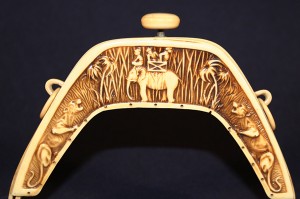 While not as common as Egyptian Revival and Asian themed purses, a number of celluloid purses do feature African themes. While the West’s interaction with Africa is as lengthy as its exchange with Egypt, the use of African themes can be traced to a series of later events during the 1800s.
While not as common as Egyptian Revival and Asian themed purses, a number of celluloid purses do feature African themes. While the West’s interaction with Africa is as lengthy as its exchange with Egypt, the use of African themes can be traced to a series of later events during the 1800s.
The discovery of gold and diamonds in 1866-1867 in South Africa and the Boer Wars (1880 – 1902) helped stir interest in Africa. In 1885, H. Rider Haggard wrote the novel “King Solomon’s Mines.” The book would become a bestseller and create a new genre, known as “Lost World” books, inspiring “The Land that Time Forgot,” “Lost World,” “The Man Who Would Be King” and more. It would also spark an interest in the mysterious “Dark Continent” that would be exploited in books, film and more.
African-themed celluloid purses feature images primarily associated with big game hunting – lions, tigers and elephants. Occasionally you will also find monkeys and giraffes, but these are extremely rare.
It would seem almost obvious that celluloid purses with their fantastical designs and themes would have frames that reflect various Roman and Greek myths. Strangely, mythological-themed celluloid purses are somewhat rare.
There’s really no explanation of this other than fashion and popular media at the time was as not fascinated with Roman and Greek myths so consequently, the purses with this theme were not manufactured en mass like other types.
When you do find these purses, the images usually include Greek warriors, famous stories like Penelope awaiting Odysseus, variations of Bacchus, the Three Graces and Persephone. You will also find a number of mythological animals, which we’ll talk about below.
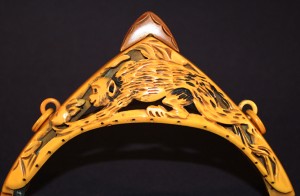 The unique aspect of animal-themed celluloid purses is that very few of them are repeated. It is possible to assemble a menagerie of animal-themed purses and not duplicate a single variation. The other unique quality of animal-themes is that the animals depicted range across a variety of continents and species.
The unique aspect of animal-themed celluloid purses is that very few of them are repeated. It is possible to assemble a menagerie of animal-themed purses and not duplicate a single variation. The other unique quality of animal-themes is that the animals depicted range across a variety of continents and species.
You’ll find household animals like cats and dogs along with esoteric animals like chameleons, giraffes, peacocks and tigers. Birds appear to be the most prevalent, but almost all of the bird frames are different.
In addition to living animals, a number of celluloid purses feature mythological animals. Griffins, dragons, basilisk and more can be found on celluloid purses.
Purses with animal themes can be placed in a number of categories. Dragons often times can be found in Asian-themed purses, while tigers and elephants can be found in African-themed purses. Finally many esoteric animals can be found in the mythological-themed purses.
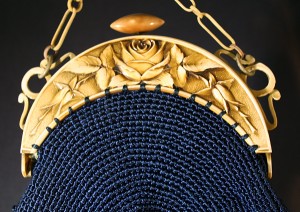 Celluloid purses with floral themes are one of the most prevalent. Quite simply, who doesn’t like a beautiful group of flowers?
Celluloid purses with floral themes are one of the most prevalent. Quite simply, who doesn’t like a beautiful group of flowers?
What makes many of these floral celluloid frames unique is that the flowers are realistically modeled in three-dimensions. This is especially true of dome-topped celluloid frames with flowers. It’s as though a group of roses are exploding out of the top of the purse.
Quite often floral themes are mixed with animal themes, especially birds. Again, you’ll find a number of unique floral themes. That being said, you will find that the most amount of repetition is in the dome-topped floral purses.
The simplest celluloid purses other than the plain frames are those with geometric designs. These frames usually have a very simple pattern done in one or two colors. The celluloid frame is usually complementary to a far more spectacular beaded purse. The simple frame allows these beaded bags to be the star.
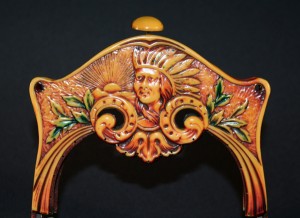 While many celluloid purses can easily be categorized, there a few that simply don’t fit in a specific category. Some of these purses can be the most beautiful and the most valuable.
While many celluloid purses can easily be categorized, there a few that simply don’t fit in a specific category. Some of these purses can be the most beautiful and the most valuable.
The most common celluloid purses that fall into the miscellaneous category are ones that feature human figural frames. Each of these frames is different. Some are three-dimensional. Others are flat but feature an unusual theme like Indians, flappers, clowns or athletes.
While it may seem like a catch-all category, you may find that some of your celluloid treasures will fall under miscellaneous.
